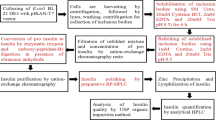Abstract
THE problem of the biosynthesis of ovalbumin is interesting since this protein seems to be synthesized from a non-homogeneous pool of intermediary peptides1–3. We have studied the biosynthesis of this protein in vivo by the laying hen using L-cystine-35S and Na2 14CO3. Selected birds were given these labelled substances and blood was obtained at stated intervals, either by heart puncture or from the wing vein. The time of laying the egg was carefully noted and ovalbumin was isolated from the egg white by ammonium sulphate fractionation. Serum globulin was isolated by precipitation with an equal volume of ammonium sulphate, while the total proteins were obtained by precipitation with trichloracetic acid to a final concentration of 5 per cent. In both cases the precipitates were repeatedly washed with 5 per cent trichloracetic acid to remove any co-precipitated amino-acids.
Similar content being viewed by others
References
Anfinsen, C. B., and Steinberg, D., J. Biol. Chem., 189, 739 (1951).
Steinberg, D., and Anfinsen, C. B., J. Biol. Chem., 199, 925 (1952).
Hendler, R. W., J. Biol. Chem., 223, 831 (1956).
Askonas, B. A., Campbell, P. N., Godin, C., Work, T. S., Biochem. J., 61, 105 (1955).
Author information
Authors and Affiliations
Rights and permissions
About this article
Cite this article
SANKAR, D., THEIS, H. Biosynthesis of Ovalbumin. Nature 183, 1057–1058 (1959). https://doi.org/10.1038/1831057a0
Issue Date:
DOI: https://doi.org/10.1038/1831057a0
- Springer Nature Limited
This article is cited by
-
Residues of Drugs in Eggs After Medication of Laying Hens for Eight Days
Acta Veterinaria Scandinavica (1975)





